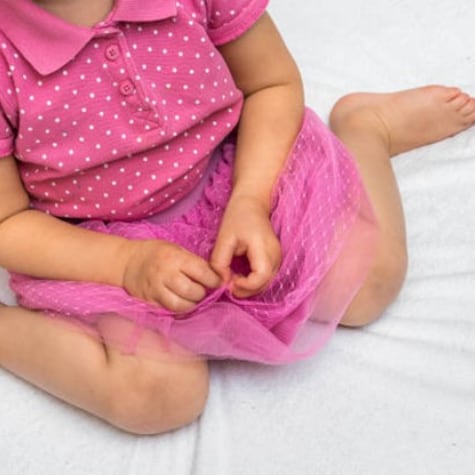Hip pain in children and teens may develop from an overuse injury, an infection or a problem that was present from birth (congenital).
And even if your child or teen does have a hip problem, he might actually complain of pain in his knee or thigh instead. That’s why it is important to know when you should take your child to a doctor to have his hip checked out.
When should your child or teen see a pediatric orthopedic specialist for hip pain?
At Children’s Healthcare of Atlanta, we recommend contacting a pediatric orthopedist about your child’s or teen’s hip problems if:
- The pain continues to develop and doesn’t go away with at-home treatments.
- You see signs of infection.
- Your child or teen doesn’t want to bear weight on the side of the hip injury.
- Symptoms become more severe and more frequent.
- Soreness after a workout lasts more than a few days.
A Second Opinion Helps a Patient Follow His Football Dreams
-
Teen Football Kicker Overcomes FAI After Second Opinion at Children’s
When Brandon was diagnosed with femoroacetabular impingement (FAI), he was told he would have to hang up his football gear—for good. Not ready to give up on his dream of being a collegiate football kicker, Brandon's family turned to Children's to get him back in the game.
Hip
The hip joint is a simple ball and socket joint. A ball-shaped piece of bone fits inside a socket, allowing movement in many directions.
- The ball, or femoral head, is at the top of the thighbone.
- The socket, or acetabulum, is in the pelvic bone.
The surfaces of the hip joint are covered with a smooth, cushioning layer called articular cartilage. A slippery liquid called synovial fluid allows the two adjoining bones to move smoothly.
The ball and socket join in the hip to help keep the hip stable. A layer of cartilage called the labrum surrounds the socket and provides more depth and stability. The hip is also surrounded by a joint capsule, which adds even more stability.
The hip is one of the largest joints in the body and absorbs a lot of stress during daily activities, such as walking, running or jumping. Some of the strongest muscles in the body attach around the hip joint, enabling us to do these activities.
Pelvis
The pelvis is made up of the sacrum and coccyx (tailbone) of the spine, along with the innominate bones (ilium, ischium and pubis) that fuse together during puberty to provide protection for many of our organs, muscles and neurovascular structures. Injury to the pelvic area can result in major damage to those other important structures.
Pelvic injuries are quite rare in children, but when they happen, they can be quite serious. These injuries are almost always severe and often involve injuries to other organs inside the pelvis, such as blood vessels. Though pelvic injuries are typically due to high-energy trauma, such as car accidents, they can also occur during other activities like playing sports.
Hip conditions in children and teens are much different than hip conditions in adults. A child’s hip condition that is left untreated could lead to larger problems later in life, such as long-term pain, discomfort, or issues with walking or sitting.
Our orthopedic specialists are trained in recognizing and treating pediatric hip conditions, including:
- Apophysitis (pelvic apophyseal injuries)
- Apophyseal avulsion fracture
- Developmental dysplasia of the hip (DDH)
- Femoroacetabular impingement (FAI)
- Femoral neck stress fracture
- Groin muscle (adductor) strain
- Hip fractures
- Hip pain
- Legg-Calve-Perthes disease
- Pelvic avulsion injuries
- Pelvic ring fractures
- Slipped capital femoral epiphysis (SCFE)
- Snapping hip syndrome
- Sports hernia (athletic pubalgia)

W Sitting and Hip Pain in Kids
At Children’s, we treat a wide range of hip conditions in kids. Tim Schrader, MD, Medical Director of the Hip Program at Children’s, weighs in on W sitting, the importance of stretching, and shares a few tips for keeping young hips healthy at any stage of development.
learn moreSupport on Facebook
Your child’s or teen’s treatment will depend on the type of injury and how it is affecting him. Our team uses advanced techniques and cutting-edge diagnosis research to care for your children and teens with hip conditions. We tailor our approach for each patient and will work with you to create a treatment plan just for your child.
Evaluations and diagnostic tests for children’s hip conditions and injuries may include:
- Arthrograms
- Blood tests
- Bone scans
- Complete medical history and physical examination performed by a doctor
- CT scans
- MRIs
- Ultrasounds
- X-rays
Management and treatments for hip issues may include:
- Medications
- Casting or bracing (orthotics)
- Pain management
- Physical therapy
- Rest (reduced activity, crutches, wheelchair or traction)
- Sports medicine
- Surgery
- Femoral head redirection surgery for SCFE
- Hip arthroscopy and surgical hip dislocation for hip impingement
- Minimally invasive techniques to treat most hip conditions, including decompression and hip distraction for treatment of Legg-Calve-Perthes disease
- Periacetabular osteotomies (Ganz) for teens and adults with hip dysplasia

Radiology for children requires specialized knowledge.
There is more cartilage in kids’ growing bones, which can make a child’s X-ray look incomplete. It’s important to see board-certified pediatric radiologists and pediatric orthopedic providers who specialize in recognizing and treating broken bones in growing kids and teens.
LEARN MOREChildren and teens’ hip conditions are much different than hip conditions in adults, so where you take them matters. We know that you want to bring your child to the best pediatric hip doctors possible. The orthopedic specialists at Children’s are trained in recognizing and treating pediatric hip conditions and working with children to help them recover more quickly. We work with patients and their families to set and reach goals together. Our Hip Program is led by Tim Schrader, MD, Orthopedic Surgeon with Children’s Physician Group–Orthopaedics and Sports Medicine.
Orthopedic surgeons
- Jed Axelrod, MD
- Robert Bruce Jr., MD
- Jorge A. Fabregas, MD
- Nicholas Fletcher, MD
- Joshua S. Murphy, MD
- Dana Olszewski, MD, MPH
- Tim Schrader, MD
- S. Clifton Willimon, MD
Orthopedist
Athens Orthopaedics
1181 Langford Drive, Building 200, Suite 101
Watkinsville, GA 30677
Buford Orthopaedics
2914 Vinson Court
Buford, GA 30518
Center for Advanced Pediatrics
2174 North Druid Hills Road NE
Atlanta, GA 30329
Children’s at Cherokee
1558 Riverstone Parkway, Suite 100
Canton, GA 30114
Children’s at Duluth
2270 Duluth Highway 120
Duluth, GA 30097-4010
Children’s at Fayette
1265 Highway 54 W, Suite 200
Fayetteville, GA 30214-4526
Children’s at Forsyth
410 Peachtree Parkway, The Collection at Forsyth
Cumming, GA 30041-7407
Children’s at Hamilton Mill–Orthopaedics and Sports Medicine
2069 Teron Trace
Dacula, GA 30019
Children’s at Hudson Bridge–Orthopaedics and Sports Medicine
1492 Hudson Bridge Road
Stockbridge, GA 30281
Children’s at Meridian Mark
5445 Meridian Mark Road NE
Atlanta, GA 30342-4755
Children’s at Old Milton Parkway
3300 Old Milton Parkway
Alpharetta, GA 30005
Children’s at Town Center Outpatient Care Center
605 Big Shanty Road NW
Kennesaw, GA 30144-3646
Children’s Orthopedics and Sports Medicine – Douglasville
Opening September 6, 2022
6095 Professional Parkway,
First Floor, Suite 101B
Douglasville, GA 30134
Macon
1625 Hardeman Ave
Macon, GA 31201
Contact Us 404-255-1933



